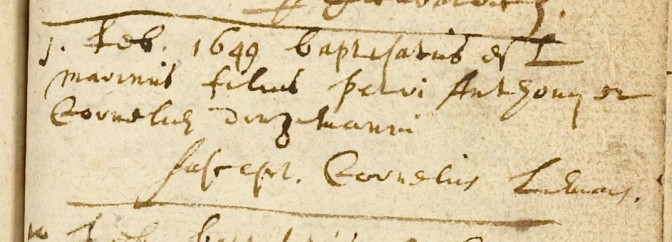If the last name of your ancestor ends in -s, -se, -sen, or -en, it could originally have been a patronymic; a name derived from the name of the father. Common examples are Jansen [son of Jan], Pieters [son of Pieter] or Cornelissen [son of Cornelis]. Other names are more difficult to recognize as a patronymic, such as “Flooren” [son of Floris], “Dielen” [son of Egidius], or Celen [son of Marcel].
Patronymics were common in most parts of the Netherlands. In the northern provinces, most people used patronymics exclusively before 1811. In the western and southern provinces, people often used patronymics in combination with a last name. From 1811 onwards, the civil registration required hereditary last names.
If you encounter an ancestor with a name that looks like a patronymic, two things could be going on:
- It could be a true patronymic. In that case, the patronymic will reflect the first name of the father.
- The patronymic could have evolved into a hereditary last name. That could have happened at any point before 1811.
Finding the first person who used a patronymic is always exciting, since it will tell you how the family got its name.
My mother’s maiden name is Marijnissen, meaning “son of Marinus.” Her ancestor Marinus Peters was baptized in Chaam, Brabant in 1649. His son Joannes called himself Marijnissen, and so did his children and further descendants in the male line. My own son is named Marijn, after my mother’s last name and indirectly after that Marinus Peters who was born in 1649.

Baptism of Marinus Peter Antonissen. Roman Catholic Church (Chaam), 1 February 1649.


Researching my Dutch ancestors from the US has been fascinating. Finding your website has been incredibly helpful. I am confused about patronymics and how they relate to ‘maiden name’ and ‘married name.’ I exclusively use MyHeritage to build my tree. My specific question is, prior to 1811, when a woman married a man who had a first name and a patronymic, what was her ‘married’ name? and do I use her patronymic as her ‘maiden’ name or her ‘middle’ name? I’m not sure if this is the right place to ask a question, but I did want to let you know how much I appreciate what you’re doing.
I am trying to understand dutch Patronymic names. This is a friesan birth record that I am trying to track down.
I have the following
Klaas Klases (or Klazes)
(He made his last name to Plaats in 1811, so it was Klaas Klazes Plaats.)
First born son of Klaas Klazes was: Marten Klazes
Second born son of Klaas Klazes was: Jan Klazes
As I understand often the first born son was name after Father’s Father, and the second born after the mother father.
So in this obscure case was Klaas Klazes father a Klaas as well? or was his father a Marten?
Awesome website!! Thanks for the great information and resources!
Normally, if somebody is called Klaas Klases, that means “son of Klaas” so the father would be Klaas. In rare cases, people are named after someone including their patronymic, so there’s a small chance Klaas was named for someone named Klaas Klases. Whenever you’re dealing with patronymics and naming patterns, we have to check that the usual rules apply in this case. I’d say that his father is probably Klaas. It might be that you haven’t found the first son yet, or that this family deviated from the regular naming pattern in naming their children.